
Europe and Mediterranean: Adriatic with Croatia & Italy Cruise
Princess Cruises
Once home to ancient civilizations and famous philosophers, the Mediterranean continues to define tradition. Depart from Rome to explore Pompeii's ruins while visiting Naples and get a taste of hand-picked local produce in Corfu.

Executive Member Benefit
Executive Members receive an annual 2% Reward, up to $1,250, on qualified Costco Travel purchases
Digital Costco Shop Card
Member Exclusive: Digital Costco Shop Card with every Princess Cruises® sailing†
Sailing Itinerary

Note: Cruise itineraries are subject to change. Please verify ports and times directly with the cruise line.
Overview
Located about 80 kilometers northwest of Rome, the Port of Civitavecchia is the port of Rome and a busy ferry and cargo port serving Italy and southern Europe. Lying on Italy’s eastern shores on the Tyrrhenian Sea, the Port of Civitavecchia has excellent direct connections to Rome. It is an important cruise and ferry port with regular passage to Sardinia, Malta, Sicily, Tunis, and Barcelona. Fishing is of secondary importance to the Port of Civitavecchia. In addition to ocean-going traffic, the Port of Civitavecchia also contains a thermoelectric center and metallurgical works. In 2006, over 51 thousand people called the Port of Civitavecchia home. The Port of Civitavecchia was built on an earlier Etruscan settlement. Emperor Trajan founded the Port of Civitavecchia in the early 2nd Century, calling it Centumcellae. Today, Trajan’s Port is preserved within today’s Port of Civitavecchia. A busy growing town during the late Roman era, the Port of Civitavecchia was attacked by Vandals and then destroyed by the Saracens in 828 AD. Residents escaped to the nearby Allumiere Mountains where Pope Leo IV built a walled town in 854. Eventually, the people returned to Civitavecchia (the name means “old city”). At the end of the 15th Century, the Port of Civitavecchia was under frequent attack by pirates. The naval arsenal was constructed in 1508. Pope Paul III commissioned the building of the keep, which was designed by Donato Bramante and then finished by Michelangelo in 1537, to protect the Port of Civitavecchia from pirate attacks. In 1696, Civitavecchia became a free port under Pope Innocent XII. Because it was Rome’s main port, the French occupied the Port of Civitavecchia in 1849. The Port of Civitavecchia was linked to Rome by the Rome and Civitavecchia Rail Road in 1859. When the Port of Civitavecchia became part of the Kingdom of Italy in 1870, it was one of the Papal State’s most strongly fortified towns when Papal troops welcomed General Nino Bixio on behalf of the Italian unification forces into the Port of Civitavecchia fortress. World War II brought destruction to as much as three-quarters of the Port of Civitavecchia. Reconstruction enlarged the Port of Civitavecchia beyond its pre-war area. The Authority Portuale Civitavecchia (Port of Rome) is responsible for managing and operating the Port of Civitavecchia as well as the ports of Fiumicino and Gaeta. The modern Port of Civitavecchia is at the center of rail, road, and air networks that link it with central Italy and the world. The Port of Civitavecchia can handle about 11 million tons of cargo per year and over 1.5 million passengers. Cargoes include forest products, cereals, iron and steel, chemicals, automobiles, containers, and liquid bulk. In 2007, the Port of Civitavecchia welcomed 856 cruise vessels carrying 1.6 million passengers, and the total number of passengers using ferries and cruise vessels was 3.8 million. In 2007, the Port of Civitavecchia handled a total of 7.7 million tons of cargo. This total included 1.5 million tons of liquid bulk, 1.7 million tons of solid bulk, 4.6 million tons of packages, and 31.1 thousand TEUs of containerized cargo. The Port of Civitavecchia contains 28 berths of a total of 5.6 thousand meters in length alongside depths from 6 to 18 meters. Port properties include five warehouses containing 36 thousand square meters for handling and storing cargo. The intermodal terminal includes seven thousand square meters of storage space and 12.5 thousand square meters for loading/unloading rail cars and parking. The Port of Civitavecchia is one of the busiest ferry ports in the world. Just 80 kilometers northwest of Rome, it is the main tourist destination for people traveling to the Eternal City. It is also a central port for ferries carrying passengers to more local destinations. The ferry terminal offers a complete line of amenities. Different ferry companies offer services to various destinations. Moby Lines handles crossings to Olbia, Sardinia. Corsica Sardinia Ferries runs services to Golfo Aranci. Grimaldi Ferries carries passengers to Barcelona and Tunis, and Grand Navi Veloci operates a route to Tunis. Ferrovie dello Stato operates a combined rail-ferry service to Golfo Aranci.
Overview
Corfu Town (Kerkyra) is a principal port and the largest town in the Ionian islands. It is built between two Venetian castles, having its unique atmosphere. It is a thriving mass of shops and businesses, set amongst a captivating and charming assortment of elegant buildings, churches, imposing fortresses, and narrow alleyways leading to hidden squares. The tall buildings with the 'volta' (arches), the 'cantina' (narrow flagstoned streets), and the 'meralgia' (sea walls) are showing all a clear Italian influence. One of the most beautiful walks in the town is around the Esplanade (Spianada square), one of the biggest squares in Europe which is the hub of the Corfiot's life. Here you can walk around or sit in one of the many cafe bars underneath the arches of the 'Liston', a name probably derived from a similar promenade in Venice. Liston was built during the imperial French occupation and is reminiscent of the larger 'Arcades' of the Rue de Rivoli in Paris. On the upper side of the Esplanade stands a memorial to the British Lord High Commissioner Sir Thomas Maitland, built in 1816 in the shape of a circular building with Ionian columns. The Corfiots called this building 'sterna' (cistern) because this was where the entrance to the largest underground cistern of the town was to be found. Near the Maitland's monument, in front of the building where the Ionian Academy was housed, stands the statue of John Capodistrias, the first President of Greece. It is a work from the end of the 19th century showing the Governor standing deep in thought. Opposite the Liston is the Old Fortress and 'Anthonas', the Municipal Gardens. In the gardens is the statue of Lord Guilford, showing the founder of the Ionian Academy in his academic robes holding an open book. Nearby are the busts of two famous Corfiots, the poet Lorenzo Mavilis and the writer Dinos Theotokis. At the northern end of the Esplanade stands the Palace of St. Michael and St. George, one of the most elegant buildings in Corfu. Opposite the west front of the palace is a beautiful building that now houses the Reading Society of Corfu, the oldest cultural institute in modern Greece, founded in 1836. The Reading Society contains a unique library of Greek and foreign books as well as a large collection of manuscripts, newspapers, periodicals, paintings, maps and engravings mostly related to the Ionian islands. As one's gaze leaves the Esplanade, after lingering on the palace, it embraces a magnificent view towards the coastal road (Arseniou Street) with its sea walls Following along this road will take you to the Old Harbour of Corfu and the other Venetian castle, the one called the New Fortress. Along this road, the narrow lanes ('cantounia') lead to the Campielo, the oldest quarter of the town. Here the visitor can find the oldest houses and many of the historic churches in Corfu. At the northern end of Capodistria Street stands the Capodistria Mansion, an excellent example of neo-classical architecture. It was built in 1835 by the Corfiot architect John Chronis and is considered one of the most beautiful buildings in Greece. Here John Capodistrias, the first President of Greece, was born. Another notable landmark in the old town is the central market. The most interesting street here is Nickiforou Theotoki as the rows upon rows of 'volta' standing on their stone columns and the tall buildings form one of the most characteristic aspects of Corfu Town. In a little square on Nickiforou Theotoki Street stands the building of the Ionian Bank, which was built in 1846 displaying a well-proportioned facade with finely detailed Ionian pilasters and pediment. On the first floor of the building,g the Paper Money Museum is housed. At the far end of the square is the Church of St. Spyridon. It shelters the body of St. Spyridon, the patron saint of Corfu and one of the great Saints of Greek Orthodoxy, and draws a constant stream of pilgrims from all over Greece every year. On the Evgeniou Voulgareos Street stands the crenellated belfry of the Roman Catholic Church of the Annunciation a venerable building from the end of the 14th century. The whole building was destroyed in the World War II bombing, and the only remains are the belfry, two inscriptions, and a bas-relief representing war trophies. Between Evgeniou Voulgareos Street and a modern square stands the most elegant of the Venetian buildings in Corfu, the Town Hall in baroque style. At the end of Moustoxydi Street stands another building of the period of British rule, the historic Ionian Parliament. At the junction of the Garitsa coastal road and Alexandras Avenue stands the Douglas Obelisk, which also belongs to the same period, erected in honor of the Lord High Commissioner Sir Howard Douglas, to whom Corfu owes a lot of public works and philanthropic institutions.
Overview
Dubrovnik - the city of a unique political and cultural history (the Dubrovnik Republic, the Statute from 1272), of world-famous cultural heritage and beauty (inscribed on the List of World Heritage Sites by Unesco) - is one of the most attractive and famous cities of the Mediterranean. Apart from its outstanding natural beauties and well-preserved cultural and historical heritage, Dubrovnik also offers high-quality visitor opportunities. It is also the city of hotels, high ecological standards, and tourist programs, and is equally attractive in all seasons. Its geographical isolation is compensated by high traffic and communication standards - especially through air traffic and fast hydrofoil boats. The tourist development of Dubrovnik started before the First World War; quite soon, the exclusiveness of its attractions made Dubrovnik a powerful international tourist center. The sightseeing of Dubrovnik and its monuments requires several days. However, already a walk through Stradun, through narrow streets and small squares, monumental ramparts and fortresses, provides enough opportunities to experience the millennial beauty of its shell-shaped urban core, centuries of building, stone-cutting, carving and engraving, the history of the Duke's Palace, libraries, the oldest pharmacy in the south of Europe, etc. Dubrovnik offers individual choice among numerous museums and galleries, which contain the jewels of Croatian heritage. The Dubrovnik Museum in the Duke's Palace keeps 15,500 exhibits in its cultural and historical department. A collection of furniture from the 17th-19th century, uniforms of dukes and councilors, aristocratic garments, and many other items are exhibited in the authentic halls of the palace. The Maritime Museum (situated in the fortress Sveti Ivan) has several exhibits on permanent display, related to the maritime affairs of Dubrovnik and Croatia on the whole, with a particular emphasis on the history of the Dubrovnik Republic. The museum of the Franciscan monastery keeps all inventories of the old pharmacy, as well as the works of Dubrovnik jewelers, painters, and embroiders. The Museum of the Dominican Monastery exhibits valuable examples of Dubrovnik paintings from the 15th and 16th centuries, as well as sculptures, jewelry, manuscripts, incunabula, and notes (music). The treasury of the Dubrovnik cathedral keeps the relics of St. Blaise, patron of Dubrovnik, and numerous paintings and works of art. The Rupe Ethnographical Museum presents traditional occupations and the rural architecture of the region of Dubrovnik, national costumes, and hand-made textiles. Very attractive is also the Aquarium of the Institute of Biology, situated in the fortress Sveti Ivan, comprising interesting marine species. Dubrovnik has several churches, monasteries, and hotels scattered all over the town. Its coastal belt is adorned with several marinas, piers, and promenades. Because of the magnificent view of the medieval Dubrovnik, a walk along the town ramparts is a must for each visitor. A great number of Dubrovnik restaurants and taverns offer delicious specialties of local and international cuisine. Sports and recreational facilities include playgrounds, courts, and requisites for all sports in the sea and on the ground, from tennis and table tennis to sailing and yachting. There are also several gyms and fitness centers with swimming pools, saunas, massage, aerobics, solarium, box gyms, etc. Dubrovnik is famous for quality hotels. Most of them are situated on the Lapad peninsula and in the area of Ploce, southeast of the old town. The hotel complex Dubrava - --Babin Kuk on Lapad has all the features of a small town. It has a shopping center, a bank, an outpatient department, many restaurants and cafés, and a street called the "New Stradun", which connects all hotels. Dubrovnik is the city of an outstanding cultural and artistic life. The most important event in the cultural life of the city is the Dubrovnik Summer Festival (10th of July - 25th of August), traditionally held since 1950. It is a theatre and classical and folk music festival since 1956 included in the calendar of world festivals and as such one of the most famous cultural events in the world. Concerts and other performances take place on open stages in the town (Gunduliceva Poljana, Drziceva Poljana, Lovrijenac, Revelin)or in beautiful interiors of the most famous buildings (Duke's Palace, cloisters, and churches). The repertoire includes works of Croatian and world classics, performed by the leading personalities from Croatia and abroad, including several world-famous actors, directors, conductors, etc. So far several hundred of them have performed in Dubrovnik. An important part of the Festival is his performances of local (Lindo, Lado) and foreign folk music ensembles. The artistic life of Dubrovnik is characterized by numerous exhibitions taking place throughout the year. Apart from already renowned galleries - the Art Gallery (Put Frana Supila 23), its exhibition space Luza Art Centre (Stradun), Sebastian - occasional and permanent exhibitions are also held in other spaces as well. Very famous are also Dubrovnik carnival festivities - so-called Dubrovnik "karnevo" (local variant of the word "carnival"), held ever since the early Middle Ages, when they were brought from neighboring Italy. Another important event is the Feast Day of St. Blaise, also the Day of Dubrovnik (3rd of February). The feast takes place for the whole week, including religious ceremonies, a procession through the town, concerts, sports events, entertainment, and carnival programs. Excursions to Dubrovnik during that week are regularly organized.
Overview
Kotor is a fortified town on Montenegro’s Adriatic coast, in a bay near the limestone cliffs of Mt. Lovcen. Characterized by winding streets and squares, its medieval old town has several Romanesque churches, including Kotor Cathedral. It's also home to the Maritime Museum, which explores local seafaring history. Sveti Ðorde, one of 2 tiny islands off the ancient town of Perast, features a centuries-old church.
Overview
Naples, a city in southern Italy, sits on the Bay of Naples. Nearby is Mount Vesuvius, the still-active volcano that destroyed the nearby Roman town of Pompeii. Dating to the 2nd millennium B.C., Naples has centuries of important art and architecture. The city's cathedral, the Duomo di San Gennaro, is filled with frescoes. Other major landmarks include the lavish Royal Palace and Castel Nuovo, a 13th-century castle.
Overview
Located about 80 kilometers northwest of Rome, the Port of Civitavecchia is the port of Rome and a busy ferry and cargo port serving Italy and southern Europe. Lying on Italy’s eastern shores on the Tyrrhenian Sea, the Port of Civitavecchia has excellent direct connections to Rome. It is an important cruise and ferry port with regular passage to Sardinia, Malta, Sicily, Tunis, and Barcelona. Fishing is of secondary importance to the Port of Civitavecchia. In addition to ocean-going traffic, the Port of Civitavecchia also contains a thermoelectric center and metallurgical works. In 2006, over 51 thousand people called the Port of Civitavecchia home. The Port of Civitavecchia was built on an earlier Etruscan settlement. Emperor Trajan founded the Port of Civitavecchia in the early 2nd Century, calling it Centumcellae. Today, Trajan’s Port is preserved within today’s Port of Civitavecchia. A busy growing town during the late Roman era, the Port of Civitavecchia was attacked by Vandals and then destroyed by the Saracens in 828 AD. Residents escaped to the nearby Allumiere Mountains where Pope Leo IV built a walled town in 854. Eventually, the people returned to Civitavecchia (the name means “old city”). At the end of the 15th Century, the Port of Civitavecchia was under frequent attack by pirates. The naval arsenal was constructed in 1508. Pope Paul III commissioned the building of the keep, which was designed by Donato Bramante and then finished by Michelangelo in 1537, to protect the Port of Civitavecchia from pirate attacks. In 1696, Civitavecchia became a free port under Pope Innocent XII. Because it was Rome’s main port, the French occupied the Port of Civitavecchia in 1849. The Port of Civitavecchia was linked to Rome by the Rome and Civitavecchia Rail Road in 1859. When the Port of Civitavecchia became part of the Kingdom of Italy in 1870, it was one of the Papal State’s most strongly fortified towns when Papal troops welcomed General Nino Bixio on behalf of the Italian unification forces into the Port of Civitavecchia fortress. World War II brought destruction to as much as three-quarters of the Port of Civitavecchia. Reconstruction enlarged the Port of Civitavecchia beyond its pre-war area. The Authority Portuale Civitavecchia (Port of Rome) is responsible for managing and operating the Port of Civitavecchia as well as the ports of Fiumicino and Gaeta. The modern Port of Civitavecchia is at the center of rail, road, and air networks that link it with central Italy and the world. The Port of Civitavecchia can handle about 11 million tons of cargo per year and over 1.5 million passengers. Cargoes include forest products, cereals, iron and steel, chemicals, automobiles, containers, and liquid bulk. In 2007, the Port of Civitavecchia welcomed 856 cruise vessels carrying 1.6 million passengers, and the total number of passengers using ferries and cruise vessels was 3.8 million. In 2007, the Port of Civitavecchia handled a total of 7.7 million tons of cargo. This total included 1.5 million tons of liquid bulk, 1.7 million tons of solid bulk, 4.6 million tons of packages, and 31.1 thousand TEUs of containerized cargo. The Port of Civitavecchia contains 28 berths of a total of 5.6 thousand meters in length alongside depths from 6 to 18 meters. Port properties include five warehouses containing 36 thousand square meters for handling and storing cargo. The intermodal terminal includes seven thousand square meters of storage space and 12.5 thousand square meters for loading/unloading rail cars and parking. The Port of Civitavecchia is one of the busiest ferry ports in the world. Just 80 kilometers northwest of Rome, it is the main tourist destination for people traveling to the Eternal City. It is also a central port for ferries carrying passengers to more local destinations. The ferry terminal offers a complete line of amenities. Different ferry companies offer services to various destinations. Moby Lines handles crossings to Olbia, Sardinia. Corsica Sardinia Ferries runs services to Golfo Aranci. Grimaldi Ferries carries passengers to Barcelona and Tunis, and Grand Navi Veloci operates a route to Tunis. Ferrovie dello Stato operates a combined rail-ferry service to Golfo Aranci.
Onboard the Sapphire Princess
Sapphire Princess
Year Built: 2004
Year Refurbished: 2023
Double Occupancy Capacity: 2674
Swim in one of four sparkling pools, shop the boutiques or get a massage in the Lotus Spa®. Dine casually on pizza and burgers or more elegantly in one of the many formal dining rooms and specialty restaurants. And with nearly 750 balcony staterooms, there's a room with a view for you.
Activities & Services (included in cruise)

Show Lounge
- Card Room
- Casino
- Disco/Nightclub
- Game Arcade
- Movies Under the Stars®
- Theater/Show Lounge
- Beauty Salon
- Fitness Center
- Fitness Classes
- Miniature Golf
- Pool - Adults Only
- Pool - Children's
- Pool - Outdoor
- Pool - Indoor
- Sports Facilities
- Whirlpool/Jacuzzi
- Art Gallery
- Bars/Lounges
- Library
- Children's Indoor Play Area
- Children's Outdoor Play Area
- Educational Classes
- Organized Age Specific Activities
- Teen Center or Disco
- Teen Programs
- Business Center
- Duty-Free Shops/Boutiques
- Elevators
- Infirmary/Medical Center
- Religious Services
- Self-Service Laundromat
- Wedding/Vow Renewal
Activities & Services (available for an extra fee)

Full-Service Spa
- Full-Service Spa
- Spa Services/Massage
- Sauna/Steam Room
- Educational Programs
- Internet Center
- Babysitting
- Dry Cleaning/ Laundry Service

Dining Room
Main Dining
International Dining Room: After final payment, through the MedallionClass® app, you may request your dining preference with Dine My Way℠. Customize your dining experiences nightly by choosing your seating time, dining companions and dietary needs.
Pacific Moon Dining Room: After final payment, through the MedallionClass® app, you may request your dining preference with Dine My Way℠. Customize your dining experiences nightly by choosing your seating time, dining companions and dietary needs.
Santa Fe Dining Room: After final payment, through the MedallionClass® app, you may request your dining preference with Dine My Way℠. Customize your dining experiences nightly by choosing your seating time, dining companions and dietary needs.
Savoy Dining Room: After final payment, through the MedallionClass® app, you may request your dining preference with Dine My Way℠. Customize your dining experiences nightly by choosing your seating time, dining companions and dietary needs.
Vivaldi Dining Room: After final payment, through the MedallionClass® app, you may request your dining preference with Dine My Way℠. Customize your dining experiences nightly by choosing your seating time, dining companions and dietary needs.
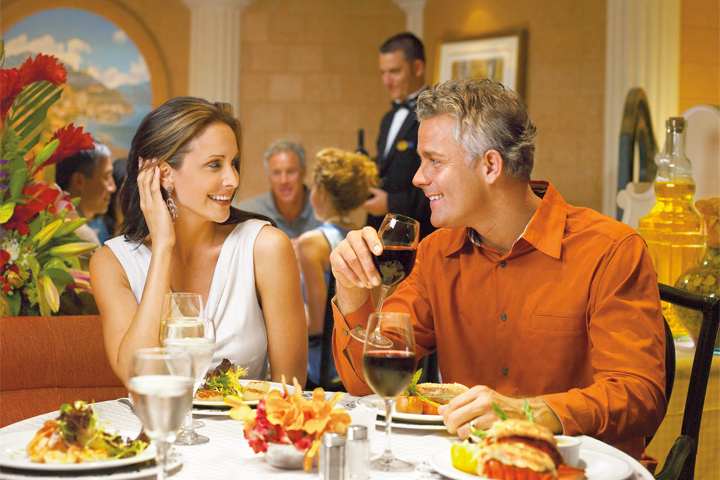
Sabatini's
Specialty Dining
Chef’s Table Experience: Taking dining to a new level, the Chef’s Table Experience includes pre-dinner cocktails and hors d’oeuvres in the galley for you and a limited number of fellow guests. After your executive chef describes the specially designed menu for the night, participants are escorted to an intimate table for the main course, including pairing suggestions. This restaurant is available for an additional cost. Limited capacity, reservations required.
Sabatini's℠: An upscale authentic Italian dining experience in a remarkable eight-course meal. The menu features both local seafood specialties and other regional favorites. This restaurant is available for an additional cost.
Sterling Steakhouse℠: An upscale and more refined approach to the traditional steakhouse, this venue features some of the best, most tender cuts of beef, such as New York and porterhouse, plus a prime rib carving station. This restaurant is available for an additional cost.
Vines: Vines boasts an extensive collection of wines, like Opus One, Super Tuscans, fine sparkling wines and regional offerings for purchase. The menu also includes wine flights and a selection of wines by the glass.
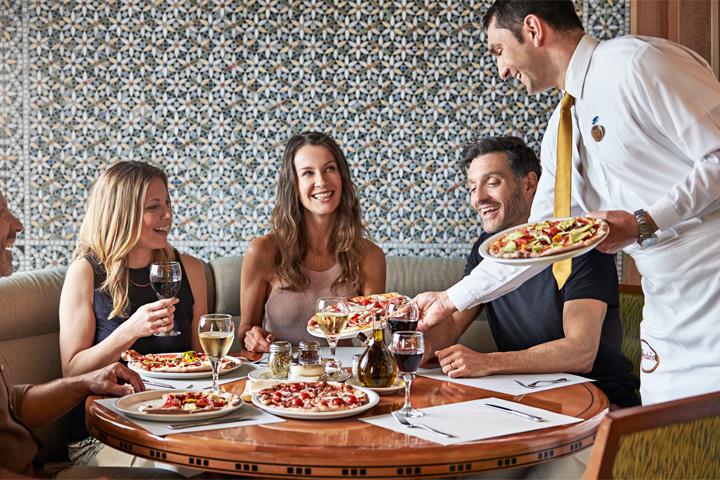
Alfredo's Pizzeria
Casual Dining
Alfredo's Pizzeria: This charming sit-down venue offers an enticing menu of freshly prepared individual-size pizzas along with beer and wines by the glass. The open kitchen design allows you to watch as the chefs create pizza by hand and serve them straight out of the oven.
Horizon Court: Horizon Court offers a buffet selection that changes throughout the day to satisfy the most discriminating palate. Indulge in a delightful array of worldwide cuisine, freshly baked breads and regional comfort foods, in a casual setting at breakfast, lunch or dinner. Enjoy fresh fruits, signature pastas and desserts galore along with your favorite beverages and customizable features like create-your-own salads and sandwiches.
International Café: Open 24 hours a day, the International Café located in the Piazza is the place for an ever-changing array of small bite meals, treats and gourmet beverages. Grab a freshly baked croissant to start your day, snack on pies and quiche or choose from a wide variety of salads and sandwiches at lunchtime, and indulge in decadent desserts in the evening. Coffee and tea fans will love the New Grounds Crafted Coffee menu featuring a variety of specialty espresso-based drinks made from a custom blend of coffee beans, as well as iced tea fusions.
Trident Grill: Follow your nose to the Trident Grill where the burgers are flipping and the hotdogs roasting, served with a variety of fixin’s and crisp fries. Veggie burgers, bratwurst and grilled chicken breast are also served and all are sure to hit the spot when you are relaxing out on deck.
Room Service: Call for room service delivery or order through OceanNow® in the Princess® MedallionClass® app at any time of the day or night. Guests with the latest Princess Plus and Princess Premier packages enjoy OceanNow® and room service delivery with no charge. Otherwise, a one-time access fee of US $ 14.99 per person per voyage will apply for OceanNow® delivery and a US $ 5 room service fee will apply for each order placed by stateroom phone. To order, guests can press the "Room Service" button on their stateroom phone, or order through OceanNow®.
Staterooms feature a refrigerator, spacious closet and bathroom with shower.
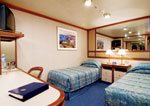
Category: IA
Approximately 168 sq. ft., this well-appointed interior stateroom provides fine amenities.

Category: IB
Approximately 168 to 182 sq. ft., this well-appointed interior stateroom provides fine amenities.

Category: IC
Approximately 168 to 182 sq. ft., this well-appointed interior stateroom provides fine amenities.

Category: ID
Approximately 168 sq. ft., this well-appointed interior stateroom provides fine amenities.

Category: IE
Approximately 168 sq. ft., this well-appointed interior stateroom provides fine amenities.

Category: IF
Approximately 168 sq. ft., this well-appointed interior stateroom provides fine amenities.
Nicely-appointed staterooms feature a picture window, spacious closet and bathroom with shower.
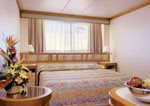
Category: O5
Approximately 200 sq. ft., this well-appointed stateroom features a forward-facing cabin for memorable views.

Category: OC
Approximately 183 to 194 sq. ft., this well-appointed stateroom features a picture window for memorable views.

Category: OF
Approximately 183 to 194 sq. ft., this well-appointed stateroom features a picture window for memorable views.

Category: OV
Approximately 183 sq. ft., this well-appointed stateroom features a picture window with an obstructed view.

Category: OW
Approximately 183 sq. ft., this well-appointed stateroom features a picture window with an obstructed view.

Category: OY
Approximately 183 sq. ft., this well-appointed stateroom features a picture window with an obstructed view.

Category: OZ
Approximately 183 sq. ft., this well-appointed stateroom features a picture window with an obstructed view.
Staterooms feature a private balcony, spacious walk-in closet, desk and bathroom with shower.
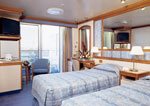
Category: B2
Approximately 277 sq. ft. including balcony, this cabin provides outstanding views from a private balcony.

Category: B4
Approximately 237 to 277 sq. ft. including balcony, this cabin provides dramatic wake views from a rear-facing private balcony.

Category: BA
Approximately 237 sq. ft. including balcony, this cabin provides outstanding views from a private balcony.

Category: BB
Approximately 237 sq. ft. including balcony, this cabin provides outstanding views from a private balcony.

Category: BC
Approximately 237 sq. ft. including balcony, this cabin provides outstanding views from a private balcony.

Category: BD
Approximately 237 to 277 sq. ft. including balcony, this cabin provides outstanding views from a private balcony.

Category: BE
Approximately 237 to 277 sq. ft. including balcony, this cabin provides outstanding views from a private balcony.

Category: BF
Approximately 237 sq. ft. including balcony, this cabin provides outstanding views from a private balcony.
Features private balcony and sitting room, two TVs, walk-in closet and bathroom with tub and shower.
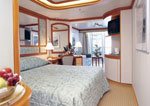
Category: M1
Approximately 354 sq. ft. including balcony, this spacious cabin provides a seating area with sofa bed, and full bath with combination tub and shower.

Category: MB
Approximately 354 sq. ft. including balcony, this spacious cabin provides a seating area with sofa bed, and full bath with combination tub and shower.

Category: MD
Approximately 354 sq. ft. including balcony, this spacious cabin provides a seating area with sofa bed, and full bath with combination tub and shower.

Category: ME
Approximately 354 sq. ft. including balcony, this spacious cabin provides a seating area with sofa bed, and full bath with combination tub and shower.
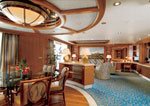
Category: S1
Approximately 1,329 sq. ft. including balcony, the Grand Suite features an expansive cabin and oversized aft-facing balcony. Enjoy exclusive suite-only upgrades and benefits.
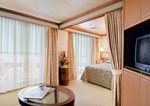
Category: S2
Approximately 692 sq. ft. including balcony, the Owner's Suite features an expansive cabin and oversized aft-facing balcony. Enjoy exclusive suite-only upgrades and benefits.

Category: S3
Approximately 525 to 572 sq. ft. including balcony, the Penthouse Suite features a spacious cabin and aft-facing balcony. Enjoy exclusive suite-only upgrades and benefits.

Category: S4
Approximately 555 sq. ft. including balcony, the Penthouse Suite features a spacious cabin and separate seating area with a sofa bed. Enjoy exclusive suite-only upgrades and benefits.

Category: S5
Approximately 705 sq. ft. including balcony, the Premium Suite features a spacious cabin and separate seating area with a sofa bed. Enjoy exclusive suite-only upgrades and benefits.

Category: S6
Approximately 525 to 548 sq. ft. including balcony, the Vista Suite features a spacious cabin and aft-facing balcony. Enjoy exclusive suite-only upgrades and benefits.

Category: S8
Approximately 613 sq. ft. including balcony, the Two Bedroom Family Suite features 2 bedrooms to accommodate up to 6 passengers. Enjoy exclusive suite-only upgrades and benefits.

| Symbol | Description |
|---|---|
 | Two-bedroom family suite (connecting staterooms with private balcony, accommodate up to six persons) |
 | Will accommodate third person |
 | Two lower beds not convertible to queen, shower only |
 | Queen bed not convertible to two twin beds |
 | Balcony access when in port only |
 | Will accommodate third and fourth person |
 | Connecting staterooms |
 | Fully accessible stateroom, roll-in shower only |
 | Will accommodate third and fourth person, fourth berth is a rollaway bed |
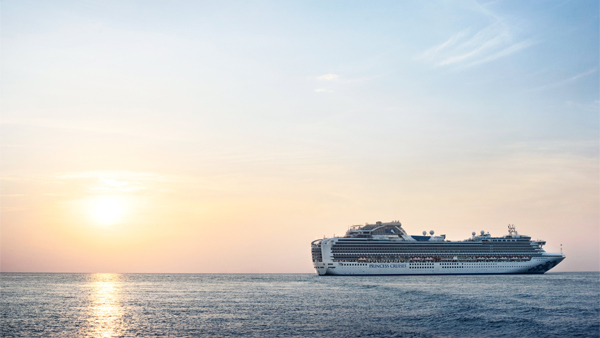
- Ship Name: Sapphire Princess
- Year Built: 2004
- Year Refurbished: 2023
- Year Entered Present Fleet: 2004
- Ship Class: Diamond
- Maximum Capacity: 2,670
- Number of Passenger Decks: 18
- Number of Crew: 1,100
- Officers' Nationality: British/Italian
- Ocean-View without Balcony: 216
- Ocean-View with Balcony: 522
- Total Inside Staterooms: 366
- Tonnage (GRT): 115,875
- Capacity Based on Double Occupancy: 2,674
- Country of Registry: Bermuda
- Total Staterooms: 1,337
- Suites with Balcony: 214
- Crew/Hotel Staff Nationality: International
Costco Member Reviews

Available Dates & Prices
Terms & Conditions
*Price shown is per person based on double occupancy and is valid for select stateroom categories only. Click on the Terms & Conditions link below for details.
†One Digital Costco Shop Card per room/stateroom, per stay. The exact amount of the Digital Costco Shop Card will be calculated during the booking process. The Digital Costco Shop Card promotion is nontransferable and may not be combined with any other promotion. A Digital Costco Shop Card will arrive by email approximately 10 days after the start of your cruise. Click on the Terms & Conditions link below for additional information.
Ship's registry: © Princess Cruise Lines, Ltd. Ships of Bermudan and British registry
Digital Costco Shop Card
Book this vacation or cruise with Costco Travel and receive a Digital Costco Shop Card. The Digital Costco Shop Card is a convenient payment option in our warehouses and on Costco.ca.












